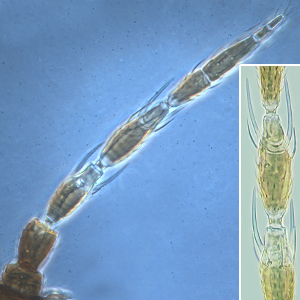Figures
Fig. 1: Antenna (inset: III. and IV. antennal segment)
Fig. 2: Head dorsal with ocellar triangle
Fig. 3: Pronotum
Fig. 4: Meso- and metanotum
Fig. 5: Forewing
Fig. 6: Sternites III and IV
Fig. 7: Tergites IV and V
Fig. 8: Tergites VIII
Taxonomic Information
Species:
Dichromothrips corbetti (Priesner, 1936)
Synonyms:
Anaphothrips corbetti Priesner, 1936
Common name:
Vanda thrips
Present taxonomic position:
Family: Thripidae Stephens, 1829
Subfamily: Thripinae (Stephens) Karny, 1921
Genus: Dichromothrips Priesner, 1932
Species Recognition
General information about the genus Dichromothrips:Species within this genus generally have a well developed endofurca spinula on the metathorax and one pair of long setae on the pronotum. The exception is Dichromothrips corbetti in which these features are significantly different, i.e. spinula not well developed and no long setae on the pronotum.
Typical character states of Dichromothrips corbetti:
Body color
Mainly brown
Antennae
Number of antennal segments: 8
Segment IV - forked sensorium: extending to a point at least 30% distal to base of segment V
Segments II and III shape: more or less symmetric
Segments III & IV sensoria: emergent and forked
Base of sensorium on antennal segment VI: no more than 2 times as wide as base of nearest seta
Terminal antennal segments: rarely elongate
Head:
Distance between bases of ocellar setae III: greater than width of first ocellus
Head shape between compound eyes: not prolonged
Ocellar setae III on head: arising on anterior margin of, or in front of, ocellar triangle
Postocular setae I: absent
Surface of head, pronotum and fore legs: without strong reticulate sculpture
Ocellar setae I in front of anterior ocellus: absent
Prothorax
Number of pairs of elongate pronotal setae: 0-3
Number of pairs of elongate posteroangular pronotal setae: 0
Pronotum shape: rectangular
Mesothorax
Mesothoracic endofurca: with median spinula
Metathorax
Metanotal median area sculptured lines: comprising about 8 transverse lines
Metanotal median setae position: arising behind anterior margin
Metanotum: without campaniform sensilla
Metanotum major sclerite: with two major sclerites, metascutum and metascutellum
Metanotum median area: with no equiangular reticulation
Metanotum sculpture: without dominant sculptured triangle medially
Metathoracic endofurca: transverse, sometimes with simple median spinula
Wings
Wings: present and more than half as long as abdomen
First vein of forewing: distinct from costal vein
Forewing anterior margin: with setae and cilia but cilia longer than setae
Forewing color: uniformly dark or shaded, but with base (or sub-base) pale
Forewing costal fringe of cilia: arising at anterior margin of wing
Forewing costal setae at middle of wing: shorter than median width of wing
Forewing first vein setal row: incomplete, with setae not closely and uniformly spaced
Forewing posterior margin cilia: undulated near apex
Forewing second vein setal row: complete, with setae closely and uniformly spaced
Forewing surface: not reticulate
Forewings: with veins, setae and microtrichia
Legs
Fore tibial apex: not extending around fore tarsus
Mid and hind tarsi: with two segments
Abdomen:
Abdominal pleurotergites: not covered in microtrichia
Abdominal segment X: never tubular, longitudinally incomplete ventrally in both sexes
Abdominal sternite II: with marginal setae but no discal setae
Abdominal sternite III of female: without glandular areas
Abdominal sternite VII median marginal setae: arising in front of margin
Abdominal sternites IV , V and VI: with marginal setae but no discal setae
Number of lateral marginal setae on abdominal tergite II: 3
Abdominal tergites: without curved wing-retaining setae
Abdominal tergites IV & V median setal pair: much shorter than distance between their bases
Abdominal tergites V-VII: without paired ctenidia, sometimes with irregular microtrichia
Setae on abdominal tergite X: slender
Surface of lateral thirds of abdominal tergites: without regular rows of fine microtrichia
Ctenidia on tergite VIII: not present, but groups of microtrichia
Tergite VIII posteromarginal comb of microtrichia: present, complete medially
Tergite VIII posteromarginal microtrichia: long, slender and regular
Tergites III to VI sculpture on lateral thirds: comprising mainly transverse parallel lines
Biology
Life history:
As with other thrips species the life cycle from egg to adult is dependent on temperature. The full cycle can take less than one week to over a month and adults may live for more than one month producing several generations in one year depending on seasonal weather (Lewis, 1973).
Host plants:
Orchids
Vector capacity:
None identified
Current known distribution:
Asia, Central and South America, North America
Additional notes:
This species has been intercepted at US ports of entry. Damaged plants and bulbs are marked with brown patches, and leaves and flowers become silvered. This species was introduced from Taiwan where it is thought to originate and has spread around the world on orchids in tropical regions and greenhouses where orchids are grown commercially.
Bibliography
Lewis, T (1973): Thrips. Their Biology,
Ecology and Economic Importance. Academic Press, New York, xvi, 350 ppg.
Moritz G, Morris DC, Mound LA (2001): ThripsID - Pest thrips of the world. ACIAR and CSIRO Publishing Collingwood, Victoria, Australia, CDROM ISBN 1 86320 296 X.
Moritz G, Mound LA, Morris DC, Goldarazena A (2004): Pest thrips of the world - an identification and information system using molecular and microscopial methods. CBIT, University of Queensland,CDROM ISBN 1-86499-781-8.
Kajita H, Hirose, Y & Takagi, M (1992): Thrips in
orchids in Thailand. Applied Entomology and Zoology. 27(1):174-175.
Mound, LA & Kibby, G (1998): Thysanoptera: An identification
guide, (2nd edition). CAB International, Wallingford and New York, 70pp.
Palmer, JM, Mound, LA & Du Heaume, GJ (1989): 2.
Thysanoptera, pp. 73. In Betts, CR [ed.], CIE Guides
to Insects of Important to Man. CAB International, Wallingford.
Links:
Mound, LA (2005): Thysanoptera (Thrips) of the World
- A Checklist. http://www.ento.csiro.au/thysanoptera/worldthrips.html









